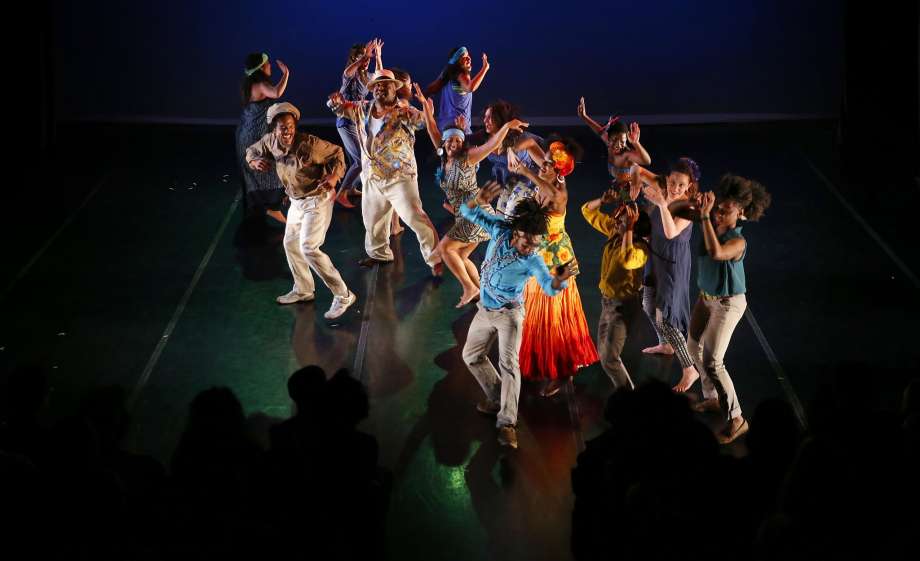 http://www.sfgate.com/performance/article/Much-to-celebrate-at-CubaCaribe-Fest-this-year-7252957.php
http://www.sfgate.com/performance/article/Much-to-celebrate-at-CubaCaribe-Fest-this-year-7252957.php
Much to celebrate at CubaCaribe Fest this year
Updated 8:30 pm, Saturday, April 16, 2016
They hovered in the cramped lobby of Dance Mission Theater, admiring each other’s costumes, refusing to leave. Downstairs, on 24th Street, festivalgoers clustered on the pavement, debating the quality of what they had witnessed for the past two hours. The sold-out opening Friday, April 15, of the 12th annual CubaCaribe Festival of Dance and Music was significant; branding the celebration one of San Francisco’s new traditions may sound somewhat oxymoronic.
But what else can you call it? What a dozen years ago was a one-weekend project has blossomed into a three-week event that transpires on both sides of the bay and involves more than 60 performers every evening. Before Friday’s concert, Dance Mission’s rabbit warren of studios and offices was transformed into impromptu rehearsal halls, blurs of color. Day of the Dead signs adorned the lobby. A young man was selling plates of the Cuban staple arroz moros (black beans and white rice). A woman in a glittering skirt slipped from room to room. And, from somewhere in the building, a persistent drumbeat raised the blood pressure a notch.
Preconceptions are quickly shattered here. The festival honors not just Cuban culture, but dances from all over the Caribbean; in addition to Cuban-influenced groups, the opening night roster included companies investigating Brazilian, Mexican and what the program calls “Brazilian Modern & Latin Dance.” This year, the festival’s founding artistic director, Ramón Ramos Alayo, asked all the participants to stick to a theme, “Cuba on My Mind.”
Local interest in movement
And from the beginning, the artists responded. In the opening, “Cubahia meu Amor,” Isaura Oliveira sang of the cultural connections between Brazil, drums pounded, dancers emerged from the wings, advanced on the audience and drew willing participants into the dance. The crowd went wild and stayed that way, cheering every swirling skirt and every percussion riff.
The warming of diplomatic relations between Cuba and the U.S. has not, Alayo believes, increased attendance at the festival. What prompted the festival’s rise is local interest in the movement itself and an increasing number of Cuban emigre dancers. That’s what Brazil-born choreographer Tania Santiago discovered when she founded her Aguas Dance Company in 1999. As she noted before the performance, Santiago earns a living as a masseuse and hairdresser, and spends her off hours with Aguas, exploring Yoruba culture. She does it mostly through a sense of community because, she says, “I love community.”
Wide range of dances
That’s part of the reason Stella Adelman, who performs in the Aguas Company, has danced in 11 of the 12 festivals. A longtime Dance Mission employee (currently its theater director), Adelman, a native San Francisco Jew, has no cultural connection to Cuban dance. But back in the Clinton era, she secured a visa to study in Cuba and “I fell in love with Caribbean dance.” She registered at Havana’s Escuela Nacional de Arte and loved the sense of individuality the school fostered. “What mattered was how you expressed yourself,” Adelman says.
Friday’s concert confirmed the wide range of dances from the diaspora. Although both concerned Yoruba culture, Santiago’s work in progress, “Fé,” bore little relation to “AfreYemaya,”a magnificent pageant José Cheo Rojas created in 2014 for his Ballet Folklorico Odduara. Gorgeous glittery costumes and headdresses, machete-wielding studs and a superb live vocal ensemble prompted an ovation.
Alayo is always on the lookout for new talent. Making its festival debut, Cuicacalli Dance Company dazzled with a replication of a Veracruzana party, in which the gorgeous white costumes and phenomenally percussive and detailed footwork astonished one and all. Choreographer Jesus Cortes is one to remember.
It is in festivals like these, Alayo believes, that the best of diaspora dance will be preserved. Don’t look to Cuba. Notes Alayo: “Cubans excel in the arts, sports and medicine. Now, with the lifting of the embargo in Cuba, they will all probably look for higher-paying jobs at McDonald’s.”
Allan Ulrich is The San Francisco Chronicle’s dance correspondent.
12th Annual CubaCaribe Festival: 7 p.m., Sunday, April 17. $20-$25, Dance Mission Theater, 3316 24th St., S.F. 8 p.m. Friday-Saturday, April 22-23, Sunday, April 24. $25-$30, Laney College Theater, 900 Fallon St., Oakland. 8 p.m. Friday-Saturday, April 29-30. $25-$30, Brava Theater, 2781 24th St., S.F. www.brownpapertickets.com, www.cubacaribe.org.


